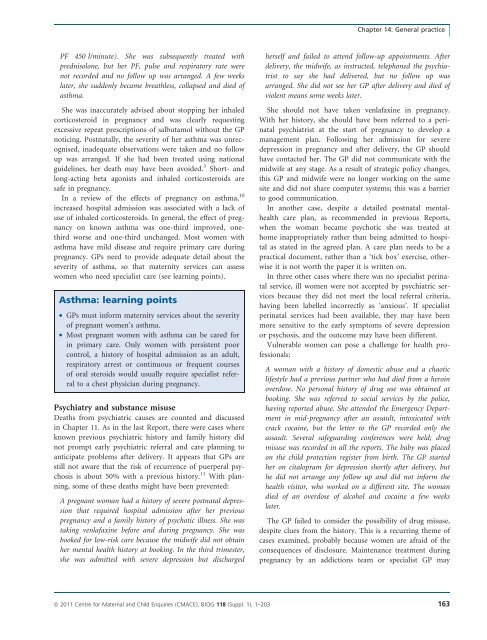6.-March-2011-Saving-Mothers-Lives-reviewing-maternal-deaths-to-make-motherhood-safer-2006-2008
6.-March-2011-Saving-Mothers-Lives-reviewing-maternal-deaths-to-make-motherhood-safer-2006-2008
6.-March-2011-Saving-Mothers-Lives-reviewing-maternal-deaths-to-make-motherhood-safer-2006-2008
Create successful ePaper yourself
Turn your PDF publications into a flip-book with our unique Google optimized e-Paper software.
Chapter 14: General practicePF 450 l/minute). She was subsequently treated withprednisolone, but her PF, pulse and respira<strong>to</strong>ry rate werenot recorded and no follow up was arranged. A few weekslater, she suddenly became breathless, collapsed and died ofasthma.She was inaccurately advised about s<strong>to</strong>pping her inhaledcorticosteroid in pregnancy and was clearly requestingexcessive repeat prescriptions of salbutamol without the GPnoticing. Postnatally, the severity of her asthma was unrecognised,inadequate observations were taken and no followup was arranged. If she had been treated using nationalguidelines, her death may have been avoided. 3 Short- andlong-acting beta agonists and inhaled corticosteroids aresafe in pregnancy.In a review of the effects of pregnancy on asthma, 10increased hospital admission was associated with a lack ofuse of inhaled corticosteroids. In general, the effect of pregnancyon known asthma was one-third improved, onethirdworse and one-third unchanged. Most women withasthma have mild disease and require primary care duringpregnancy. GPs need <strong>to</strong> provide adequate detail about theseverity of asthma, so that maternity services can assesswomen who need specialist care (see learning points).Asthma: learning points• GPs must inform maternity services about the severityof pregnant women’s asthma.• Most pregnant women with asthma can be cared forin primary care. Only women with persistent poorcontrol, a his<strong>to</strong>ry of hospital admission as an adult,respira<strong>to</strong>ry arrest or continuous or frequent coursesof oral steroids would usually require specialist referral<strong>to</strong> a chest physician during pregnancy.Psychiatry and substance misuseDeaths from psychiatric causes are counted and discussedin Chapter 11. As in the last Report, there were cases whereknown previous psychiatric his<strong>to</strong>ry and family his<strong>to</strong>ry didnot prompt early psychiatric referral and care planning <strong>to</strong>anticipate problems after delivery. It appears that GPs arestill not aware that the risk of recurrence of puerperal psychosisis about 50% with a previous his<strong>to</strong>ry. 11 With planning,some of these <strong>deaths</strong> might have been prevented:A pregnant woman had a his<strong>to</strong>ry of severe postnatal depressionthat required hospital admission after her previouspregnancy and a family his<strong>to</strong>ry of psychotic illness. She wastaking venlafaxine before and during pregnancy. She wasbooked for low-risk care because the midwife did not obtainher mental health his<strong>to</strong>ry at booking. In the third trimester,she was admitted with severe depression but dischargedherself and failed <strong>to</strong> attend follow-up appointments. Afterdelivery, the midwife, as instructed, telephoned the psychiatrist<strong>to</strong> say she had delivered, but no follow up wasarranged. She did not see her GP after delivery and died ofviolent means some weeks later.She should not have taken venlafaxine in pregnancy.With her his<strong>to</strong>ry, she should have been referred <strong>to</strong> a perinatalpsychiatrist at the start of pregnancy <strong>to</strong> develop amanagement plan. Following her admission for severedepression in pregnancy and after delivery, the GP shouldhave contacted her. The GP did not communicate with themidwife at any stage. As a result of strategic policy changes,this GP and midwife were no longer working on the samesite and did not share computer systems; this was a barrier<strong>to</strong> good communication.In another case, despite a detailed postnatal mentalhealthcare plan, as recommended in previous Reports,when the woman became psychotic she was treated athome inappropriately rather than being admitted <strong>to</strong> hospitalas stated in the agreed plan. A care plan needs <strong>to</strong> be apractical document, rather than a ‘tick box’ exercise, otherwiseit is not worth the paper it is written on.In three other cases where there was no specialist perinatalservice, ill women were not accepted by psychiatric servicesbecause they did not meet the local referral criteria,having been labelled incorrectly as ‘anxious’. If specialistperinatal services had been available, they may have beenmore sensitive <strong>to</strong> the early symp<strong>to</strong>ms of severe depressionor psychosis, and the outcome may have been different.Vulnerable women can pose a challenge for health professionals:A woman with a his<strong>to</strong>ry of domestic abuse and a chaoticlifestyle had a previous partner who had died from a heroinoverdose. No personal his<strong>to</strong>ry of drug use was obtained atbooking. She was referred <strong>to</strong> social services by the police,having reported abuse. She attended the Emergency Departmentin mid-pregnancy after an assault, in<strong>to</strong>xicated withcrack cocaine, but the letter <strong>to</strong> the GP recorded only theassault. Several safeguarding conferences were held; drugmisuse was recorded in all the reports. The baby was placedon the child protection register from birth. The GP startedher on citalopram for depression shortly after delivery, buthe did not arrange any follow up and did not inform thehealth visi<strong>to</strong>r, who worked on a different site. The womandied of an overdose of alcohol and cocaine a few weekslater.The GP failed <strong>to</strong> consider the possibility of drug misuse,despite clues from the his<strong>to</strong>ry. This is a recurring theme ofcases examined, probably because women are afraid of theconsequences of disclosure. Maintenance treatment duringpregnancy by an addictions team or specialist GP mayª <strong>2011</strong> Centre for Maternal and Child Enquiries (CMACE), BJOG 118 (Suppl. 1), 1–203 163


